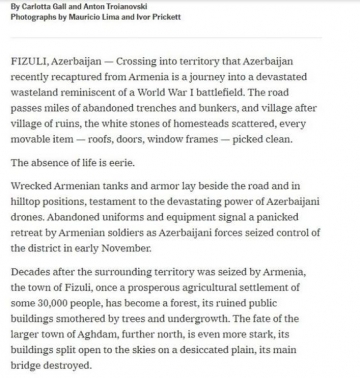The New York Times published an article by Carlotta Goll, head of the Istanbul bureau of this publication, entitled "Injuries, tragic situation and destruction after the Nagorno-Karabakh war." Goll visited the territories liberated from the Armenian occupation and got acquainted with the terrible situation during the 30-year aggression of Armenia against Azerbaijan. AZERTAC reports that the author notes that everyone who came to the area recently liberated from the Armenian occupation by the Azerbaijani Army was faced with a scene reminiscent of the battlefield of the First World War. There are empty ditches and bunkers along the road for several kilometers, destroyed villages, and the rest of the houses have no roofs, doors or windows. Tanks and armored vehicles thrown by Armenians in the hills are evidence of the destructive power of unmanned aerial vehicles belonging to the Azerbaijani Army.
It is clear that the Armenian soldiers retreated in fear during the six-week war. The city of Fizuli was once a prosperous settlement. Public buildings in the center of the region, with a population of about 30,000, mainly engaged in agriculture, were destroyed. The fate of the city of Agdam, located a little north of Fizuli, was even more tragic. The article notes that the Nagorno-Karabakh conflict was one of the most difficult territorial conflicts in the world to resolve. When a ceasefire agreement was reached in 1994, Armenia occupied not only Nagorno-Karabakh, but also adjacent territories, expelling more than 800,000 Azerbaijanis living there. After six weeks of heavy military operations, the Azerbaijani Army has regained control of the Fizuli and Agdam regions, and the military operations ended with the declaration of a ceasefire with the mediation of Russia. Goll also got acquainted with the impressions of Armenian servicemen who took part in the war with Azerbaijan. Armenian soldiers were horrified when the deadly drones were mentioned. According to them, the strikes of the drones were so accurate that the soldiers entered the battlefield with tanks, opened fire, and then jumped and fled to the shelters. "It was a real hell," said the Armenian commander, Colonel Alexanyan.
The author then writes about the destruction he saw in the cities of Fizuli and Agdam. Nureddin Namazaliyev, a former IDP from Fizuli, said that in the 1990s, a close relative of a prisoner of war was forced to demolish houses in Agdam. The head of the Aghdam region's executive power, Vagif Hasanov, said that the city's 19th-century central mosque was the only surviving building in the region. Armenians used this building as a barn and polluted it. The printing house, cinema and cultural center in Fizuli were destroyed, and the main mosque in the city was destroyed. The author writes that the vineyards in this region have been completely destroyed. Azerbaijani officials promise that peace will be declared with Armenians living in the liberated territories and they will be given the same status as other citizens.
The mediators tried to create conditions for Azerbaijani refugees to return to some regions, including Agdam and Fizuli, but for years Armenia prevented this and tried to recognize the independence of Nagorno-Karabakh or separate it from Azerbaijan. The Azerbaijani leadership did not agree to these terms. Another aggravating factor is that Armenian politicians and activists around the world have begun to claim that the occupied territories, including those adjacent to the former Nagorno-Karabakh, belong to Armenia. In August 2019, Armenian Prime Minister Nikol Pashinyan visited Nagorno-Karabakh and said: "Arsakh is Armenia." Besides, Funds funded by members of the Armenian Diaspora have long insisted on resettling Armenians in the occupied Azerbaijani regions outside the former Nagorno-Karabakh Republic, saying that these regions are also "legitimate territory of Armenia."
